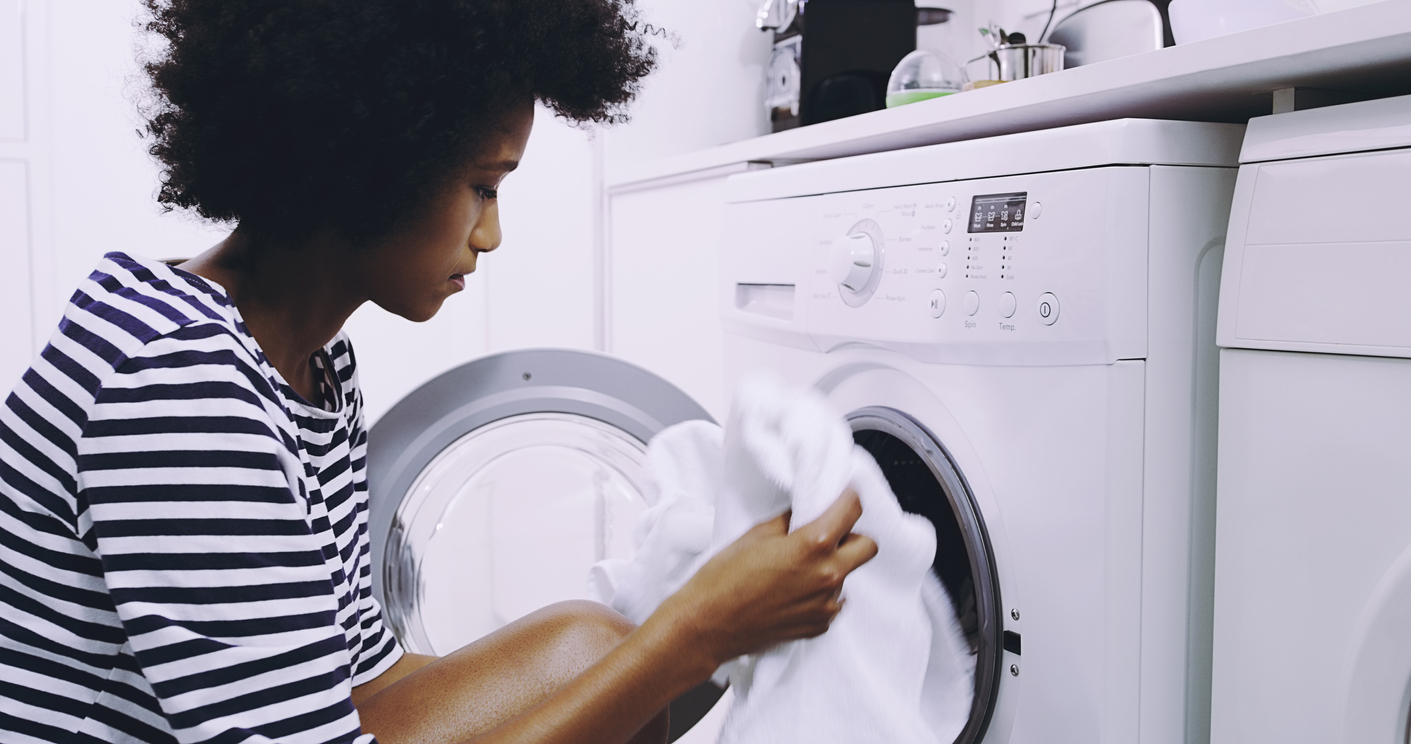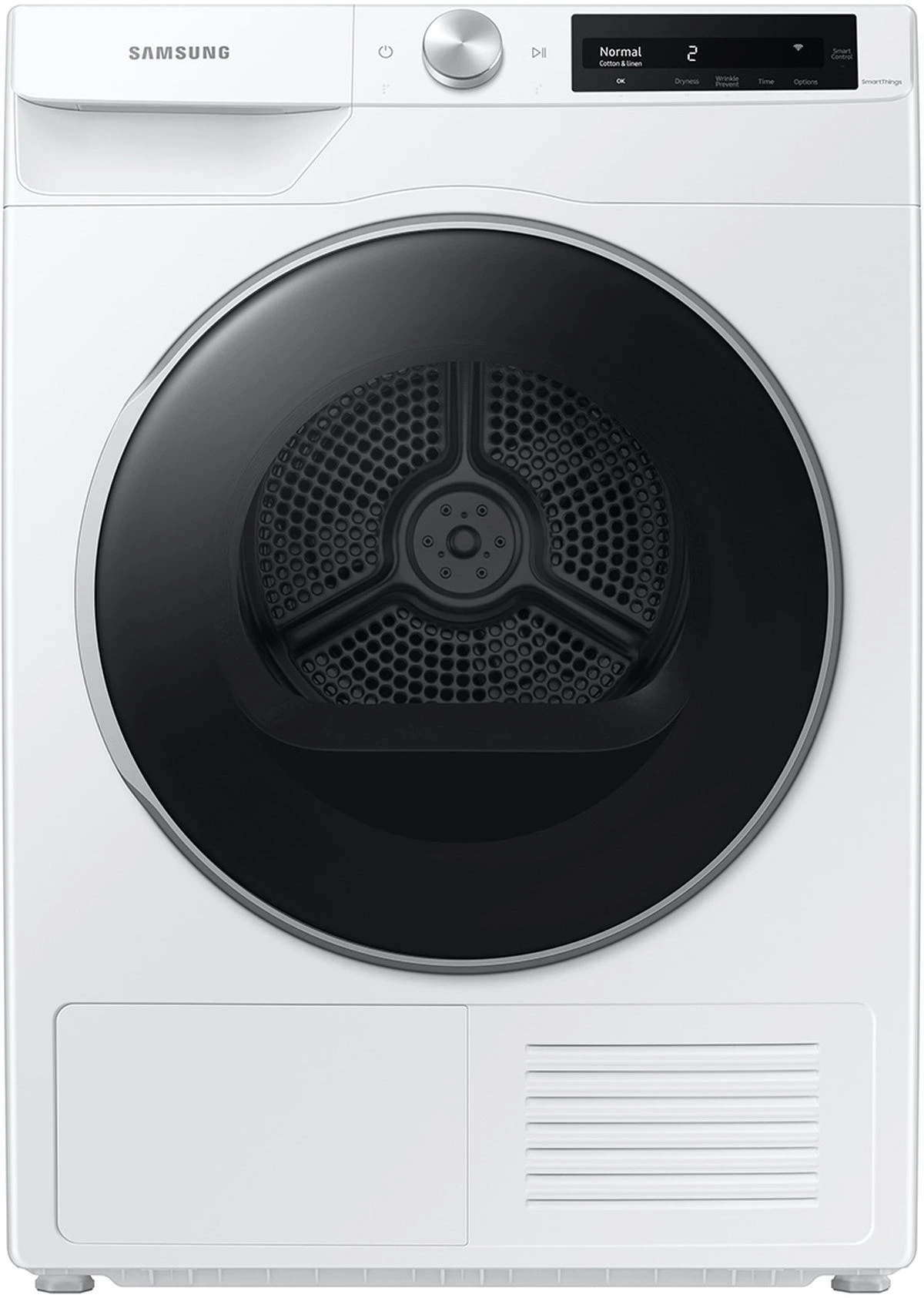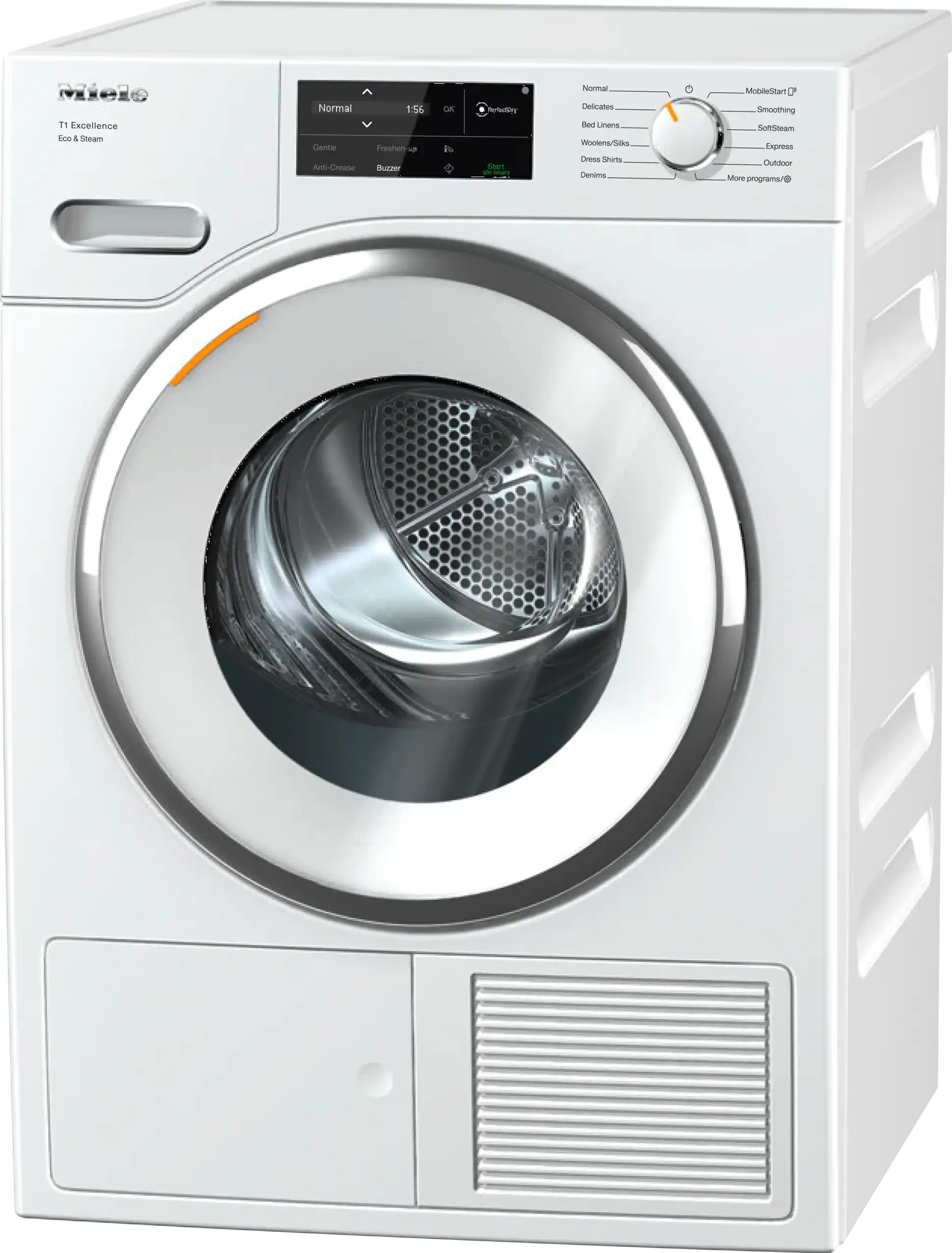
At a Glance:
How Does a Heat Pump Dryer Work?
What to Know Before Buying a Heat Pump Dryer
If you’re looking to upgrade and find the best washer and dryer sets, you’ve probably come across one of the most innovative drying appliances: a heat pump dryer. Below we will talk about what a heat pump dryer is, how it works, and how much money you can save by using an energy-efficient heat pump dryer. We will also discuss all the things you should consider before purchasing a heat pump dryer. Is it the right appliance for you and your household? Finally, we will talk about the various brands that currently produce heat pump dryers and then we will feature two heat pump dryers: one from Samsung and one from Miele.
What is a Heat Pump Dryer?
Heat pump dryers are starting to become more popular as homeowners look to use energy-efficient and cost-saving appliances. They are also popular appliance choices for small homes and apartments. So what is a heat pump dryer? Unlike a standard electric dryer that vents water, lint, and heat outside, a heat pump dryer doesn’t need to vent any of that outside. Instead, the heat from a heat pump dryer is recycled within the dryer itself. These dryers are considered energy-efficient dryers and ventless heat pump dryers. Because a vent is not needed, homeowners have more options when it comes to where the dryer will be installed. Instead, the heat from a heat pump dryer is recycled within the dryer itself.
How Does a Heat Pump Dryer Work?
The biggest difference between how a heat pump dryer works and how a regular dryer works involve how the heat is used. To start, hot air is blown out from one heat exchanger and is sent through a compressor to make the air even hotter. At the same time, a second heat exchanger pulls moisture (humid air) from the clothes. The second heat exchanger takes the humid air and cools it enough so that it becomes condensed water. Finally, the condensed water is collected in a drip tray or tube (occasionally this drip tray will need to be removed and emptied out). This cycle continues as air is used and reused for each load of laundry.
Shop Dryers at Friedmans
DryersEnergy Usage and Saving Money
One of the best parts about heat pump dryers is how much money they save. Heat pump dryers use way less energy than electric dryers—up to 50% less energy! Since air is constantly recycled within a heat pump dryer, less energy is needed overall. To explain how much money a heat pump dryer could save you, let’s compare the average cost of drying between a heat pump dryer and a regular dryer.
Heat pump dryer: $0.17 - $0.33 per load
Regular electric dryer: $0.53 - $0.55 per load
So, for example, if a household runs 7 dryer cycles per week, every week, that would equate to a cost of $61.88 to $120.12 per year with a heat pump dryer and $192.92 to $200.20 per year with a regular electric dryer. That’s about an $80 to $130 difference in savings each year.
The difference in savings and energy usage comes from how hot air is used within each type of dryer. Regular dryers are constantly pulling in more heat for each cycle as heat expels out a vent. Heat pump dryers, on the other hand, do not need to pull in more heat as they reuse the hot air that’s already within the unit.
What to Know Before Buying a Heat Pump Dryer
Now that you know how much money you could save per year with a heat pump dryer, you may be ready to run out and purchase your very own heat pump dryer. But before you do so, it is important to get a full picture of a heat pump dryer to make sure it will be the best fit for you and your household. Here are a few heat pump dryer pros and cons to consider before making a purchase.
Low Maintenance
Heat pump dryers are pretty low maintenance compared to standard dryers. There are fewer ‘parts’ to deal with as a heat pump dryer doesn’t need a dryer vent or duct. Heat pump dryers are also smaller, so there’s less to clean. You may need to regularly empty the dryer’s water tank if it doesn’t already connect to your washer’s water drain.
Longer Drying Time
Compared to a regular dryer which has an average drying time of 30 to 45 minutes per load, a heat pump dryer has an average drying time of 50 to 80 minutes per load. If time is of the essence, a heat pump dryer is probably not the best dryer choice for you.
Smaller Capacity
Average electric dryers can hold more clothes than heat pump dryers. To compare, regular dryers usually have a capacity of 5 to 7 cubic feet whereas heat pump dryers are much smaller with a capacity of about 4 cubic feet. Heat pump dryers are not a good choice for households that need a large number of clothes washed often.
Higher Upfront Cost
Regular electric dryers are about $500 to $800 on average. On the other hand, heat pump dryers are priced similarly to luxury washers and dryers usually starting at $1,000 and increasing in price from there. While heat pump dryers are more expensive, they don’t require vent installation and save money per load in the long run.
Is a Special Set Up Required?
Unlike regular dryers that require a heating vent and duct to be installed, heat pump dryers don’t use vents or ducts. They also don’t need to be connected to a water drain. This makes installation a breeze as a heat pump dryer is basically a freestanding dryer.
Who Makes Heat Pump Dryers
Some of the best heat pump dryer brands are Bosch, Miele, LG, Samsung, and Whirlpool. Heat pump dryers are fairly similar in price among varying brands although there are more budget-friendly brands, like LG. Below is a brief breakdown of each brand, what types of heat pump dryers they offer, and the average price of their units:
- Miele. Miele offers 3 heat pump dryer models with an average price of $1,832 per dryer. These units include features like Miele@home Wi-Fi connectivity and SteamFinish.
- Bosch. Bosch has 1 heat pump dryer model that features HomeConnect and Anti-Vibration walls. Prices are around $1,500.
- LG. LG currently produces one heat pump dryer with ThinQ Care and a reversible door option. Prices are around $1,300.
- Samsung. Samsung offers 1 heat pump dryer model with an Express Cycle and Smart Care. Prices are around $1,600.
- Whirlpool. Whirlpool has two heat pump dryer models with Intuitive Touch Controls and Advanced Moisture Sensing. Prices are around $1,800.
Heat Pump Dryer Reviews
Below we will review two heat pump dryers; one from Samsung and one from Miele. Both heat pump dryers have the same size capacity (4 cubic feet) and can both connect to smartphones via Wi-Fi. We will discuss their individually unique features below.
Samsung 4.0 Cu. Ft. Heat Pump Electric Dryer

The Samsung Heat Pump Electric Dryer provides a gentle way to dry your clothes without the use of a vent. Because a vent is not needed, there are more spaces in the home where this heat pump can be safely installed. It can even be installed inside a closet since it’s only 25.81” deep (standard-size dryers are about 32 to 34 inches deep). With Heat Pump Technology, clothes can be dried in a way that is energy-efficient and cost-effective. This Samsung Heat Pump Dryer can even connect to your smartphone with Wi-Fi connectivity. Through your phone, you can start and stop your dryer, schedule cycles, and more. Finally, this dryer includes an AI Smart Dial which conveniently learns your favorite cycles and recommends them.
- Model: DV25B6900HW
- Dimensions: 23.63” W x 33.5” H x 25.81” D
- Weight: 110.2 lbs.
Miele T1 4.0 Cu. Ft. White Edition Lotus White Heat-Pump Tumble Dryer

The Miele Heat Pump Dryer from Miele is more expensive than the Samsung model but offers a bit more features. To start, this heat pump dryer doesn’t require any cleaning as the heat exchanger is protected by the Miele Filtration System. With EcoDry Technology, the heat exchanger is never clogged up with lint, so there are no blockages or power reductions. This helps dry clothes efficiently and economically. Another feature, PerfectDry, assesses the water’s calcium content and adjusts the drying process to make sure clothes are dried perfectly. Like the Samsung model, this Miele heat pump dryer can also connect to smartphones for remote access. Some other fun features include an intelligent lint filter, MultiLingua (information can be displayed in several languages), AddLoad (add extra clothes during the cycle), and Wash2Dry (same program as washing machine is used).
- Model: TXI 680WP
- Dimensions: 23.50” W x 33.50” H x 25.38” D
- Weight: 135 lbs.
.png)
Why Trust Friedmans Appliance?
Established in 1922, Friedmans Appliance has been the most trusted name in the Bay Area for over 100 years. What started as a small appliance store in Oakland has expanded to include every appliance you need for your home. Our commitment to value, inspiration, and character has only grown, creating an unbeatable reputation for top-notch appliances. At Friedmans, we strive to give our customers the best of the best, including our selection of top appliance brands and our exceptional customer service. Speaking of which, we offer a 100-day price guarantee on all our products — the longest in the industry!
Our wide selection of appliances is just one of the reasons we’re the best Bay Area appliance store. We carry refrigerators in every style, every cooking appliance to show off your chef skills, and every dish care and laundry appliance you need for cleanup.
Shop Heat Pump Dryers at Friedmans
See for yourself why Friedmans is a trusted name in the Bay Area and shop heat pump dryers online. While we are located in Pleasant Hill, we deliver to all of Northern California — even Reno! If you have any questions, our team is always happy to help you find your next Heat Pump Dryer, whether you call us at 925-808-2950, email us, or use our online chat feature. Better yet, stop by our appliance store in Pleasant Hill to experience the quality in person. Visit us today!
Learn More: 5 Luxury Washer and Dryer Bundles Worth the Investment
